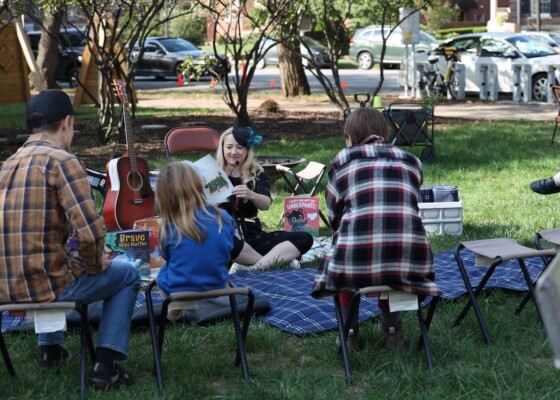Frankenstein Friday: Katie Osborn Scholar Essay
July 13, 2018This week, we take a break to reflect on Victor’s choice in making the creature a mate with this essay from scholar Katie Osborn. While working towards her PhD at…

This week, we take a break to reflect on Victor’s choice in making the creature a mate with this essay from scholar Katie Osborn. While working towards her PhD at Notre Dame, Katie Osborn’s research focused on eighteenth- and nineteenth-century British and Irish literature. In addition to her research, she has also taught classes on Writing and Rhetoric, Sustainability, Film and Television, and Science Fiction. She also served as co-director of Notre Dame’s Seminar in Eighteenth and Nineteenth Century Studies with Profs. Yasmin Solomonescu and Greg Kucich.
Read:
Essay: “Stealing from the Womb”Katie Osborn
University of Notre Dame
Mary Shelley’s Frankenstein is a novel about gender and technology that explores a man’s attempt at creating new life without a female partner. Kenneth Branagh’s adaptation of Frankenstein captures better than other Frankenstein film the “birth myth” and “horror story of Maternity” (4) at the heart of Mary Shelley’s novel, showing Victor Frankenstein’s attempt to commandeer the science and mysticism of reproduction from women. (5) In Branagh’s 1994 film, Victor births his creature in a massive steampunk womb—replacing everything female with scientific substitutes. After nine months of construction (or gestation), the creature is attached to a uterine chassis with umbilical electrical wiring, bathed in a nutrient syrup, and animated by life- giving electrical eels. In both the film and the novel, we witness Victor undergo mental and bodily transformations during the creature’s gestation and its laborious birth. As Anne K. Mellor explains, Shelley’s “focus on the birth-process illuminates for a male readership hitherto unpublished female anxieties, fears, and concerns about the birth-process and its consequences.” (6) But many have argued that Victor’s attempt to take for himself this reproductive power also reinforces the way in which his society devalued women, for his action robs women of their primary biological and social function. (7) Thus Shelley’s path-breaking science fiction story, while it probes many areas of ethics and technology, is also at its heart a story about gender arrangements, parenthood, and female sexuality.
Many literary scholars begin or complement their studies of Frankenstein with the facts of its author’s life. It is well known that Shelley’s mother, Mary Wollstonecraft, died from complications following her daughter’s birth. Mary Wollstonecraft Godwin Shelley was herself pregnant during most of the composition of Frankenstein, losing her first daughter in 1815 before the child had even been named. The baby’s death inspired dreams of re-animation that would be echoed in Frankenstein: in 1815, Shelley wrote in her journal, “Dream that my little baby came to life again; that it had only been cold, and that we rubbed it before the fire, and it lives.” (8) Her son William was born in 1816, and daughter Clara followed in mid-1817. In the time just before and during Frankenstein’s composition, therefore, Shelley was mourning the death of her first child; carrying, bearing, and nursing two more children; and pursuing a strict program of reading and writing under the guidance of Percy Shelley.(9) She read voraciously in philosophy, science, poetry, and horror literature. She also read her parents’ works and journals, which included Mary Wollstonecraft’s Vindication of the Rights of Woman as well as William Godwin’s comments on his trysts with Wollstonecraft that led to their daughter’s conception (nights spent “Chez moi” or “Chez elle”). (10) So sex, death, and creation (both biological and literary) were all intertwined for Shelley. Haifaa Al-Mansour’s forthcoming “Mary Shelley” biopic (11) makes much of these associations, releasing publicity portraits of the teenage author composing on her mother’s grave—a favorite spot that was also allegedly where she explored her emerging sexuality with the poet Percy Shelley. (12)
Sex, death, and creation are also intertwined throughout Frankenstein, which is inevitable in a novel that ponders the consequences of a man stealing the life- and death-giving powers of the womb. An important context for Victor’s actions is the ideology of “separate spheres” just emerging in Shelley’s time. Men were conceptually associated with public life, leadership, ownership, subjective inner lives, the abilities to theorize and think of things in non- literal, figurative ways; women were conceptually associated with nature, objects, family, the literal, and the home. (13) Female reproduction, desire, and intellect were only “proper” when they occurred in the privacy of the home, the bedroom, and the parlor. The flipside of this is that child-oriented work was women’s most important social role, a realm in which they had ultimate authority, although male philosophers important to the Romantic period (especially Jean- Jacques Rousseau) were beginning to erode the privilege of women as primary educators and caregivers. Thus Mellor writes, “Frankenstein’s scientific project—to become the sole creator of a human being—supports a patriarchal denial of the value of women and of female sexuality.” (14) Victor wants to control this power, and, in so doing, he leaves women with little to contribute according to his own limited view of his society.
What really frightens Victor is the threat of powerful female sexuality. Victor decides to destroy his female creature when he realizes that his creature’s mate, probably made out of corpses of female criminals and prostitutes—these would be the easiest materials to procure— might not be interested in his ugly creature. As Ruth Franklin observes, “The monster has a face that only a mother could love—but he has no mother.” (15) Victor fears that the female creature will have her own sexual preferences and will be capable of reproduction (even cross-breeding with human males), becoming a mother herself. His fears have a long precedence in Western literature, echoing Milton’s Paradise Lost: “what misery th’inabstinence of Eve / Shall bring on men.” (16) “She might become,” Victor worries, “ten thousand times more malignant than her mate.” (17) She might create, through the pursuit of her sexual desires, chaos and death.
In the novel, these disturbing and illicit associations between sexuality, birth, and death appear over and over. Following the creature’s birth, Victor dreams he embraces his fiancée Elizabeth only for her to transform into his mother’s rotting corpse. Fearing the female creature that he is constructing, Victor rends its (presumably naked) body to pieces with his bare hands. And, finally, Victor finds Elizabeth murdered in their marriage bed. The creature himself, made and not born, is a walking reminder of the ways in which Victor has transgressed the boundaries of gender and nature. Instead of following a more natural cycle of birth, life, and death, Victor continually disrupts the patterns of life. Perhaps for this reason, the bonds of love that ought to connect Victor to his family, his fiancée, and his offspring—feelings that nineteenth-century readers would have called the “social passions”—have lost their grip. It is hard not to see Shelley’s own unconventional and disrupted upbringing reflected in the patterns of loss and revenge acted out in her novel. After all, this story about a neglectful but authoritative father was dedicated to William Godwin, Mary Wollstonecraft Shelley’s own father.
In 1831, Shelley described the novel as her “hideous progeny,” drawing a direct comparison between the text and the creature it depicts. Did she see her composition of this ambitious and controversial novel as analogous to Victor Frankenstein’s creation? A female writer born of radical parents (Wollstonecraft and Godwin) and entangled with two of the maddest, baddest and most dangerous male poets of her time (Percy Shelley and Lord Byron), Shelley was keenly aware of the precariousness of her position in society. Reflecting on her controversial theme, the 1831 preface seeks to underplay the radical visions of technology and gender she had depicted, musing, “supremely frightful would be the effect of any human endeavor to mock the stupendous mechanism of the Creator of the world.” (18) But Victor’s action is radical, for he challenges the place of humans in the natural world by asserting the power to create a new species. The potential unforeseen consequences of this action—termed the “Frankenstein factor”—are extremely relevant to twenty-first century audiences facing, for instance, the realities of in vitro fertilization (the way I myself was created) or genetically engineered plants and animals.
Victor’s “fatal impulse” to create life out of dead matter encourages reflection on the violence embedded in male fantasies of discovery and creation, whether scientific, medical or geographical. Frankenstein also inspires questions about gender and power in our time. His creation of the first member of a new species subverts the biological and cultural roles of men and women by placing reproductive power solely in male hands. From our 2018 perspective, Shelley seems to be criticizing Victor’s act of stealing women’s power of the womb for himself and his positivist eighteenth-century perspective. But we should also pause to consider to what extent women and other vulnerable people have full autonomy over their own bodies in our time. Women, immigrants, veterans, people of color and trans people can all face barriers to control over their bodies and their futures, in much the same way that Victor sought to control the lives and fates of his new species. Like other great works of science fiction, Shelley’s novel pushes us to redefine our visions of gender, technology, and the roles of both in society.
***
Bibliography
4 Ellen Moers, “Female Gothic: The Monster’s Mother” in Frankenstein (ed. J. Paul Hunter. New York: W. W. Norton, 1996), 216.
5 Mary Shelley’s “Frankenstein.” Dir. Kenneth Branagh. 20th Century Fox, 1994.
6 Mary Shelley: Her Life, Her Fiction, Her Monsters (New York: Methuen, 1988), 41.
7 Anne K. Mellor, “Possessing Nature: the Female in Frankenstein,” in Frankenstein (Norton, 1996), 274 86; Leanne MacDonald, “Vegetable Love: Reimagining Sexuality in Frankenstein and “Christabel,’” Atenea XXXV (2015), 4359.
8 Ruth Franklin, “Was ‘Frankenstein’ Really About Childbirth?” The New Republic. 7 March 2012. Access online at: https://newrepublic.com/article/101435/maryshelleyfrankensteingodwinbodleian oxford
9 For more details of Shelley’s reading habits and pedagogical philosophy, see Mary Shelley’s Reading, edited by Stuart Curran (2009). Access online at: https://www.rc.umd.edu/editions/frankenstein/MShelley/reading
10 Franklin (see above).
11 Mary Shelley. Dir. Haifaa alMansour. IFC Films. 2017.
12 Gordon, Charlotte. Romantic Outlaws: The Extraordinary Lives of Mary Wollstonecraft and her Daughter Mary Shelley (New York: Random House, 2015), 80.
13 These gendered expectations of men and women are described throughout Mary Poovey’s The Proper Lady and the Woman Writer, but they are a special focus of her chapter on Mary Shelley, “‘My Hideous Progeny’: The Lady and Monster” (U. of Chicago P., 1984), 11442.
14 Mary Shelley, 2201.
15 Franklin (see above).
16 John Milton, Paradise Lost 11:4767 in The Milton Reading Room (ed. Thomas H. Luxon, March 2015). Access Online at: https://www.dartmouth.edu/~milton/reading_room/pl/book_11/text.shtml
17 Frankenstein (ed. D. L. Macdonald and Kathleen Scherf. 3rd Edition. Ontario: Broadview Editions, 2012), 174.
18 “Appendix I: Introduction to Shelley’s 1831 Edition” in Frankenstein (Broadview, 2012), 3501.
Think:
1. Because of the “Frankenstein factor”—the fact that new creations may have regrettable, unexpected consequences—should new inventions or therapies go through rigorous testing before being made available to the public? Even if keeping them out of the hands of some people would cause suffering or even death?
2. Some scholars and readers argue that the creature is not born cruel, but becomes so after being abandoned by his creator/parent and by the kind De Lacey family. In his own words, “The mildness of my nature had fled, and all within me was turned to gall and bitterness.” But Victor, who experiences a childhood amongst a loving family and which “No youth could have passed more happily,” undertakes actions as destructive as the creature. If we cannot put their actions down to either “nature or nurture,” what causes Victor and the creature to take actions that will harm other people? And what could their families or their society have done to stopped them?
3. How would you characterize Victor’s relationships with the women in his life? Do you think his desire to “birth” the creature has anything to do with his attitude towards women? Why or why not?
4. Why does Victor destroy the female creature? What does he fear?
Talk:
Find out how Frankenstein is coming to life in your own community
! Organizations throughout Indiana are offering book discussions, read-a-thons, hands-on activities, film screenings and more exploring the big ideas at the heart of Frankenstein. Subscribe to FrankenNews for updates about how Frankenstein is coming alive for Hoosiers in 2018! Share your thoughts on social media using #itsalive.
One State / One Story: Frankenstein is an Indiana Humanities program and has been made possible in part by a major grant from the National Endowment for the Humanities and in partnership with the Indiana State Library and Indiana Center for the Book. Any views, findings, conclusions, or recommendations expressed in this program do not necessarily represent those of the National Endowment for the Humanities.


